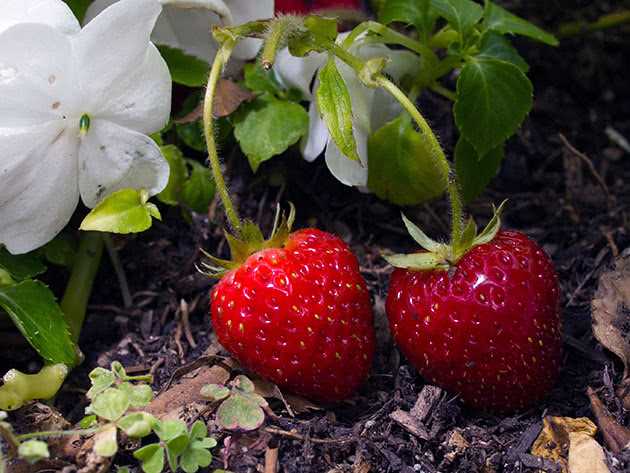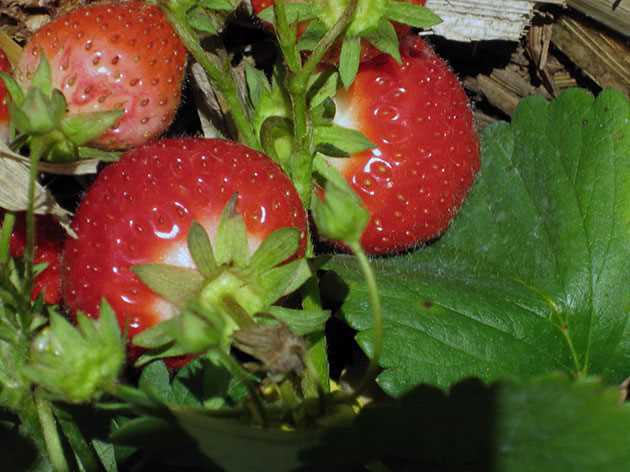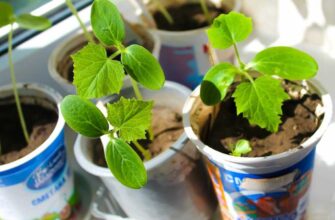- Клубника ремонтантная: особенности и выращивание
- Секреты ухода за ремонтантной клубникой
- Выбор места для высадки ремонтантной клубники
- Подготовка почвы для выращивания ремонтантной клубники
- Правила посадки ремонтантной клубники
- Удобрения для ремонтантной клубники: как и когда применять
- Полив ремонтантной клубники: частота и режимы
- Обрезка ремонтантной клубники: основные методы
- Защита ремонтантной клубники от болезней и вредителей
- Лучшие сорта ремонтантной клубники: описание и особенности
- 1. Сорт «Марафет»
- 2. Сорт «Александрия»
- 3. Сорт «Селена»
- Сбор и хранение урожая ремонтантной клубники
- Применение ремонтантной клубники в кулинарии и косметологии
- В кулинарии
- В косметологии
- Вопрос-ответ:
- Какие существуют секреты выращивания клубники ремонтантной?
- Как защитить клубнику ремонтантную от болезней?
- Какие лучшие сорта клубники ремонтантной можно посадить?
- Какую почву выбрать для выращивания клубники ремонтантной?
- Какой режим полива рекомендуется для клубники ремонтантной?
- Видео:
- Селекционер о мужских и женских кустах клубники. Как определить стерильные сорта земляники.

Клубника ремонтантная — это особый вид клубники, который отличается от обычной плодоношением несколько раз в течение сезона. Это означает, что вы можете наслаждаться свежими ягодами не только летом, но и осенью. Однако, чтобы достичь хороших результатов при выращивании такой клубники, необходимо знать некоторые секреты.
Несмотря на свою устойчивость к морозам, клубника ремонтантная может страдать от различных болезней. Одной из наиболее распространенных проблем является серая гниль, которая поражает ягоды и может привести к потере урожая. Для защиты от болезней необходимо правильно ухаживать за растениями, обеспечивая им достаточное освещение, полив и вентиляцию.
Выбор правильных сортов клубники ремонтантной также является важным аспектом успешного выращивания. Одним из самых популярных сортов является «Мара». Он отличается крупными и сладкими ягодами, а также хорошей устойчивостью к болезням. Еще одним вариантом является сорт «Альбион», который имеет отличный вкус и высокую урожайность. Однако, выбор сортов зависит от ваших предпочтений и условий выращивания.
Выращивание клубники ремонтантной может стать интересным и прибыльным занятием, если вы будете следовать секретам выращивания, обеспечивать защиту от болезней и выбирать лучшие сорта. Не бойтесь экспериментировать и делиться своими результатами с другими садоводами — так вы сможете создать идеальные условия для успешного выращивания клубники ремонтантной.
Клубника ремонтантная: особенности и выращивание

Клубника ремонтантная — это один из видов клубники, который отличается от обычной клубники (не ремонтантной) тем, что может плодоносить несколько раз в течение сезона. Это делает ее особенно привлекательной для садоводов, которые хотят получить урожай свежей клубники на протяжении всего лета.
Одна из особенностей выращивания ремонтантной клубники — это правильный выбор сорта. Существует множество сортов ремонтантной клубники, каждый из которых имеет свои особенности и преимущества. Некоторые сорта отличаются большими плодами, другие — высокой устойчивостью к болезням.
При выращивании ремонтантной клубники необходимо учитывать ее особенности и требования. Она предпочитает солнечные места, хорошо пропускающие влагу почвы и регулярное поливание. Также ремонтантная клубника требует обязательной обрезки после каждого плодоношения, чтобы обеспечить растению достаточное количество света и питательных веществ.
Одним из главных врагов ремонтантной клубники являются болезни. Для защиты растений от болезней необходимо соблюдать санитарные правила, регулярно удалять сухие и больные листья, а также обрабатывать растения специальными препаратами. Также рекомендуется использовать высококачественное семенное материал и следовать рекомендациям по выращиванию каждого конкретного сорта.
Секреты ухода за ремонтантной клубникой

Выращивание ремонтантной клубники требует особого внимания и ухода. Важно выбрать подходящие сорта, которые адаптированы к климатическим условиям вашего региона и имеют хорошую устойчивость к болезням.
Подготовка почвы: Для успешного выращивания ремонтантной клубники необходимо выбрать плодородную почву. Перед посадкой рекомендуется провести подготовку почвы, внося органические удобрения, такие как компост или перегной.
Правильное поливание: Ремонтантная клубника требует регулярного полива, особенно в период активного роста и плодоношения. Важно не допустить пересыхания почвы, но и избегать излишнего застоя влаги, чтобы не вызвать гниение корней. Рекомендуется поливать клубнику утром или вечером, избегая полива в солнечные часы.
Уход за растениями: Клубнику следует регулярно пропалывать, удалять сорняки и рыхлить почву вокруг растений. Это поможет сохранить влагу в почве и предотвратить развитие сорняков, которые могут забирать питательные вещества у клубники. Также рекомендуется проводить обрезку усынов и поврежденных побегов для стимуляции роста и формирования компактных кустов.
Защита от болезней: Ремонтантная клубника может быть подвержена различным болезням, таким как серая плесень или фитофтороз. Для предотвращения поражения рекомендуется проводить профилактическую обработку растений специальными препаратами, а также соблюдать правила санитарной обрезки и уборки погибших растений.
Следуя этим секретам ухода за ремонтантной клубникой, вы сможете получить обильный урожай в течение всего сезона и наслаждаться вкусными и ароматными ягодами.
Выбор места для высадки ремонтантной клубники

Ремонтантная клубника является популярной культурой для выращивания в саду. Однако, для того чтобы получить хороший урожай, необходимо правильно выбрать место для высадки.
Первое, на что следует обратить внимание, это освещенность. Ремонтантная клубника любит солнечные места, поэтому выбирайте участок с хорошей солнечной экспозицией. При этом, следует помнить, что клубника также нуждается в некотором укрытии от сильного ветра.
Также важно обратить внимание на почву. Ремонтантная клубника предпочитает рыхлую и плодородную почву. При подготовке грядки для посадки, рекомендуется вносить органическое удобрение, чтобы обеспечить необходимые питательные вещества для растения.
Необходимо также учесть сорта клубники, которые вы планируете выращивать. Некоторые сорта предпочитают более влажные условия, в то время как другие более устойчивы к засухе. Поэтому, при выборе места для высадки, обратите внимание на влажность почвы и доступность системы полива.
В целом, выбор места для высадки ремонтантной клубники играет важную роль в успешном выращивании этой культуры. Учитывайте освещение, почву и потребности сортов, чтобы обеспечить здоровый рост и обильный урожай.
Подготовка почвы для выращивания ремонтантной клубники

Выращивание ремонтантной клубники начинается с правильной подготовки почвы. Важно выбрать подходящую площадку для посадки и обеспечить ей оптимальные условия.
Перед посадкой рекомендуется провести анализ почвы, чтобы определить ее состав и уровень кислотности. Ремонтантные сорта клубники предпочитают нейтральную или слегка кислую почву, с pH около 6. При необходимости можно добавить известняк или серу для коррекции кислотности.
Для обеспечения хорошего роста и развития растений рекомендуется подготовить почву, внесши в нее органические удобрения. Важно помнить, что клубника — культура, требовательная к питательным веществам. Перед посадкой можно внести перегной, компост или другие органические удобрения, чтобы обогатить почву полезными веществами.
Также стоит учесть, что ремонтантные сорта клубники более чувствительны к заболеваниям, поэтому рекомендуется обработать почву перед посадкой антисептиком или препаратами, предотвращающими развитие болезней. Это поможет снизить риск поражения растений различными инфекциями и сохранить урожайность клубники на высоком уровне.
Правила посадки ремонтантной клубники

1. Выбор сорта
Перед посадкой ремонтантной клубники необходимо определиться с выбором сорта. Существует множество различных сортов ремонтантной клубники, каждый из которых имеет свои особенности и требования к выращиванию. При выборе сорта необходимо обратить внимание на его устойчивость к болезням, плодоношение, вкусовые качества и размер ягод.
2. Подготовка почвы
Для успешного выращивания ремонтантной клубники необходимо подготовить почву. Она должна быть плодородной, влажной, хорошо дренированной и богатой органическими веществами. Перед посадкой рекомендуется провести обработку почвы, удалить сорную растительность и внести удобрения. Также важно обеспечить клубнике доступ к достаточному количеству солнечного света.
3. Посадка растений
Ремонтантная клубника может быть выращена как в открытом грунте, так и в горшках или контейнерах. При посадке растений в открытый грунт необходимо соблюдать определенное расстояние между растениями, обычно около 30-40 см. Глубина посадки зависит от размера корневой системы растения. Для контейнерной посадки следует выбрать достаточно просторные горшки или контейнеры, обеспечить хорошую дренажную систему и регулярно поливать растения.
4. Уход за растениями
После посадки ремонтантной клубники необходимо обеспечить ей правильный уход. Регулярное поливание, подкормка, удаление сорняков и больных растений, обрезка побегов – это основные мероприятия по уходу за клубникой. Также рекомендуется обрабатывать растения от болезней и вредителей с использованием специальных препаратов.
5. Уборка урожая
Ремонтантная клубника начинает плодоносить уже через несколько месяцев после посадки. Уборку урожая следует проводить регулярно, собирая спелые ягоды. Убирая ягоды своевременно, можно продлить плодоношение растений и получить более крупные и сочные плоды.
Удобрения для ремонтантной клубники: как и когда применять

Выращивание ремонтантной клубники требует особого внимания к питательным веществам, поэтому удобрения играют важную роль в процессе выращивания. Правильное применение удобрений помогает клубнике ремонтантной расти здоровой и продуктивной.
Перед посадкой ремонтантных сортов клубники рекомендуется подготовить почву, добавив органические удобрения, такие как перегной или компост. Это обеспечит растения необходимыми питательными веществами и поможет им развиваться.
Во время активного роста и цветения ремонтантной клубники, рекомендуется применять минеральные удобрения. Они содержат все необходимые микроэлементы, которые помогут растениям развиваться и расти сильными. Необходимо следить за состоянием почвы и растений, чтобы определить, когда именно нужно применять удобрения.
Так стоп!!! Вы всё ещё не подписаны на наши каналы в Телеграмм и Дзен? Посмотрите: ТГ - (@historyfantasydetectivechat) и Дзен (https://dzen.ru/myshortsstorys)
Важно помнить, что избыточное применение удобрений может быть вредным для растений. Перед применением удобрений необходимо ознакомиться с инструкцией и соблюдать рекомендации по дозировке. Регулярный контроль и подкормка помогут растениям быть устойчивыми к болезням и дать более обильный урожай.
Полив ремонтантной клубники: частота и режимы

Правильный полив является важным аспектом успешного выращивания ремонтантной клубники. Он помогает предотвратить возникновение болезней и обеспечить достаточное снабжение растений водой. Чтобы достичь наилучших результатов, необходимо учитывать частоту и режимы полива.
Частота полива: ремонтантная клубника требует регулярного полива, особенно во время периодов активного роста и плодоношения. Недостаток влаги может привести к ухудшению качества плодов и замедлению их развития. Рекомендуется поливать растения 1-2 раза в неделю в течение всего сезона выращивания.
Режимы полива: чтобы достичь оптимальных результатов, следует выбрать правильный режим полива. Для ремонтантной клубники рекомендуется применять метод капельного полива или использовать систему полива с дождевателями или поливальными лентами. Это позволяет доставлять воду непосредственно к корням растений, минимизируя потери воды и предотвращая развитие грибковых заболеваний.
Важно помнить, что растения ремонтантной клубники требуют больше влаги в периоды плодоношения, поэтому режим полива следует увеличить в этот период. Кроме того, полив не рекомендуется проводить во время дождей, чтобы избежать переувлажнения почвы и развития грибковых болезней.
Используя правильную частоту и режимы полива, вы сможете обеспечить здоровый рост и хороший урожай ремонтантной клубники.
Обрезка ремонтантной клубники: основные методы
Обрезка является важной частью процесса выращивания ремонтантной клубники. Она позволяет поддерживать растение в хорошей форме, обеспечивает его здоровье и повышает урожайность. Важно знать основные методы обрезки и правильно их применять.
1. Удаление усынов и побегов. Усыновья и побеги, которые появляются у клубники, нужно своевременно удалять. Они отнимают энергию и питательные вещества, которые могли бы быть направлены на развитие основного растения. Удаление усынов и побегов помогает растению сосредоточиться на формировании ягод.
2. Отрезка сухих и поврежденных побегов. Сухие и поврежденные побеги негативно влияют на здоровье и развитие клубники. Они могут быть источником различных болезней и вредителей. Поэтому регулярное отрезание сухих и поврежденных побегов помогает предотвратить распространение болезней и сохранить растение в хорошем состоянии.
3. Обрезка усынов. Усыновья, которые все-таки успели разрастись, можно обрезать, чтобы направить энергию и питательные вещества основному растению. Обрезка усынов способствует увеличению размеров ягод и повышению их качества.
4. Обрезка после урожая. После окончания плодоношения, растение необходимо обрезать. Это позволяет удалить старые и поврежденные побеги, освободить место для новых побегов, а также способствует восстановлению и подготовке клубники к новому сезону.
Важно помнить, что обрезка ремонтантной клубники должна проводиться с особой осторожностью, чтобы не повредить основной куст и его корневую систему. При обрезке следует использовать острые и чистые инструменты, обрабатывать их антисептиком и соблюдать все правила санитарной обработки.
Защита ремонтантной клубники от болезней и вредителей

Ремонтантная клубника — это особый вид клубники, который отличается от обычных сортов своей способностью плодоносить несколько раз в год. Однако, как и любая другая культура, ремонтантная клубника подвержена различным болезням и нападениям вредителей. Для успешного выращивания и получения хорошего урожая необходимо уделить должное внимание защите растений.
Выбор устойчивых сортов. При выборе сортов ремонтантной клубники следует обращать внимание на их устойчивость к различным заболеваниям и вредителям. Некоторые сорта имеют встроенную устойчивость к определенным болезням, что позволяет снизить риск поражения растений. Приобретая саженцы, стоит обратиться к продавцу или воспользоваться информацией в интернете, чтобы выбрать подходящие сорта.
Соблюдение агротехники. Для защиты ремонтантной клубники от болезней и вредителей необходимо правильно организовать выращивание растений. Клубнику следует высаживать на солнечных участках с хорошей дренажной системой. Уход за растениями включает регулярное поливание, мульчирование почвы и своевременную подкормку. Важно также следить за состоянием растений и быстро реагировать на первые признаки болезней или вредителей.
Профилактические меры. Для предотвращения поражения ремонтантной клубники болезнями и вредителями необходимо регулярно проводить профилактические мероприятия. Это включает обработку растений специальными препаратами и средствами, а также удаление пораженных частей растений. Важно также следить за чистотой участка и уничтожать сорняки, которые могут быть источником инфекции. Регулярное проведение профилактических мер поможет снизить риск болезней и повысить урожайность растений.
Биологические методы защиты. Для защиты ремонтантной клубники от болезней и вредителей можно использовать биологические методы. Например, можно привлечь полезных насекомых, которые будут сражаться с вредителями. Также можно использовать бактерии и грибки, которые помогут бороться с различными заболеваниями растений. Биологические методы защиты являются экологически безопасными и не вредят окружающей среде.
Лучшие сорта ремонтантной клубники: описание и особенности
Ремонтантная клубника – это отличный выбор для тех, кто хочет наслаждаться свежими ягодами на протяжении всего лета и осени. Этот вид клубники отличается от обычной тем, что способен плодоносить два раза в год. Однако, чтобы получить хороший урожай, необходимо выбрать подходящие сорта.
1. Сорт «Марафет»
Сорт «Марафет» является одним из самых популярных среди любителей выращивать ремонтантную клубнику. Он отличается крупными ягодами, ярким красным цветом и сладким вкусом. Кусты этого сорта хорошо разветвлены и дают обильный урожай. Кроме того, «Марафет» устойчив к многим болезням, что делает его идеальным выбором для начинающих садоводов.
2. Сорт «Александрия»

Сорт «Александрия» обладает не только великолепным вкусом и ароматом, но и красивым внешним видом. Ягоды этого сорта имеют неправильную форму и особую глубокую красную окраску. Они также отличаются очень сладким и сочным мякотью. «Александрия» хорошо растет и плодоносит на протяжении всего сезона, что делает его идеальным выбором для долгосрочного выращивания.
3. Сорт «Селена»
Сорт «Селена» славится своей высокой урожайностью и отличной зимостойкостью. Ягоды этого сорта имеют приятный сладкий вкус и аромат. Они также хорошо хранятся и транспортируются, что делает «Селену» популярным среди коммерческих производителей. Кусты «Селены» обладают хорошей устойчивостью к различным болезням, что облегчает процесс выращивания и позволяет получить богатый урожай.
Выбирая сорт ремонтантной клубники, необходимо учитывать свои предпочтения и условия выращивания. Однако сорта «Марафет», «Александрия» и «Селена» являются отличным выбором для получения вкусных и качественных ягод на протяжении всего лета и осени.
Сбор и хранение урожая ремонтантной клубники

Сбор урожая ремонтантной клубники является важным этапом в процессе выращивания. Клубника этого сорта имеет особенность плодоношения в течение всего лета и осени, что позволяет получить несколько урожаев за сезон. Однако, чтобы сохранить качество и свежесть ягод, необходимо правильно собирать и хранить их.
Перед сбором урожая необходимо проверить клубнику на наличие болезней и повреждений. Желательно собирать только зрелые ягоды, которые имеют яркий цвет и приятный аромат. С помощью острых ножниц или ножа следует аккуратно отрезать плоды, оставляя небольшой хвостик. Это позволит улучшить сроки хранения и предотвратить повреждение ягод.
После сбора урожая ремонтантной клубники необходимо провести первичную сортировку ягод. Удалите поврежденные, перезрелые или незрелые плоды. Также стоит отделить мелкие ягоды от крупных, чтобы они не портили друг друга. Выборочно можно промыть ягоды в прохладной воде, но не рекомендуется делать это для всего урожая, чтобы не ускорить процесс порчи.
Хранение урожая ремонтантной клубники необходимо проводить в прохладных и сухих условиях. Подходят холодильник, холодная кладовая или специальные контейнеры для хранения фруктов. Перед укладкой в контейнер ягоды следует полностью высушить. Рекомендуется укладывать клубнику в один слой, чтобы избежать смятия и возможного порчи. При правильном хранении урожай ремонтантной клубники может сохраняться до нескольких недель.
Применение ремонтантной клубники в кулинарии и косметологии

Ремонтантная клубника, благодаря своей уникальной способности цветения и плодоношения, нашла применение не только в садоводстве, но и в других сферах, таких как кулинария и косметология.
В кулинарии

Клубника ремонтантная является отличным ингредиентом для приготовления разнообразных блюд. Ее сладкий и сочный вкус делает ее идеальной для использования в десертах, например в тортах, пирогах и мороженом. Кроме того, клубника может быть использована для приготовления варенья, сиропов и джемов, которые можно добавлять в йогурты, оладьи и другие блюда для придания им неповторимого аромата и вкуса.
В косметологии

Помимо кулинарного применения, клубника ремонтантная также находит применение в косметологии. Ее ягоды богаты витаминами и антиоксидантами, которые способствуют увлажнению и омоложению кожи. Из клубники можно приготовить маски и скрабы, которые помогут снять воспаление и раздражение, улучшить цвет лица и сделать кожу более упругой и увлажненной.
Таким образом, ремонтантная клубника не только радует своим урожаем и яркими цветами, но и находит применение в кулинарии и косметологии, обогащая нашу жизнь своими полезными свойствами и неповторимым вкусом.
Вопрос-ответ:
Какие существуют секреты выращивания клубники ремонтантной?
Основные секреты выращивания клубники ремонтантной включают правильный выбор сорта, подготовку почвы, регулярный полив и удобрение, а также контроль за болезнями и вредителями. Также важно знать, что клубника ремонтантная может давать урожай дважды в сезон, поэтому необходимо правильно ухаживать за растением и обрезать старые листья и цветоносы после первого урожая.
Как защитить клубнику ремонтантную от болезней?
Для защиты клубники ремонтантной от болезней необходимо соблюдать следующие меры: выбирать здоровые рассаду и качественные семена, проводить обработку протравливанием перед посадкой, регулярно осуществлять контроль за наличием вредителей и болезней, при необходимости применять фунгицидные препараты и соблюдать правильный режим полива, предотвращая переувлажнение почвы.
Какие лучшие сорта клубники ремонтантной можно посадить?
Существует множество хороших сортов клубники ремонтантной. К ним относятся, например, сорта «Альбион», «Сандрой», «Маршалл», «Темптейшн», «Фрезер», «Гиганелла» и другие. Лучший сорт для посадки зависит от предпочтений садовода, климатических условий и других факторов.
Какую почву выбрать для выращивания клубники ремонтантной?
Для выращивания клубники ремонтантной рекомендуется выбирать плодородную почву с хорошей воздухопроницаемостью и дренировкой. Желательно, чтобы почва была с нейтральной или слабокислой реакцией. Хорошим вариантом может быть смесь грунта, состоящая из песка, перегноя и торфа в определенных пропорциях.
Какой режим полива рекомендуется для клубники ремонтантной?
Для клубники ремонтантной рекомендуется умеренный режим полива. Почва должна быть достаточно влажной, но не переувлажненной. Важно учитывать климатические условия и особенности почвы. Например, в жаркую погоду может потребоваться увеличение частоты полива, а в периоды осадков полив можно сократить или приостановить.








